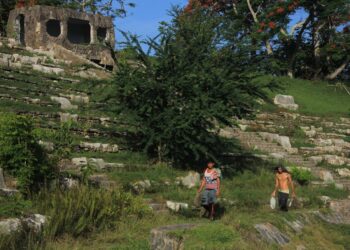Photos: Néstor Martí OHC y Alain L. Gutiérrez
On Oct. 11, 2012, after an absence of more than 200 years, a Tarasca made its return to Havana. All day long, people kept vigil over it in the Plaza of San Francisco de Asís, and late that night, the Tarasca was taken in a carnival-like procession to the mouth of Havana Bay, the Explanada de la Punta, where it was burned.
The whole process was a magnificent show performed by Gigantería, a street theater company that has been bringing its magic to the colonial district’s plazas for the last 12 years. It is a popular form of art, forged in the cobbled streets of Habana Vieja as artists interact with passers-by, turning spectators into direct actors.
As the legend goes, the Tarasca was a monster that lived outside Tarascón in France, destroying crops and sinking ships. Ancient engravings depict a horrible creature, half-lion half-dragon, with a snake’s tongue, a turtle’s shell, scales, bear paws, and a scorpion’s tail. Everyone was afraid of this beast because of its constant attacks and its ferocity; using force against it was useless, but it could be subdued by the power of Saint Martha.
From the Middle Ages, the Tarasca was viewed by Christians as a symbol of vice and paganism, and as such, it became part of the feast days of Corpus Christi, which were officially established in Europe in 1264. Effigies of the Tarasca were frequently seen leading processions, parting the crowds of curious onlookers like a triumphant entrance of the holy, and sometimes they were burned as part of a popular rite of purification.
And in Cuba, according to historic documents preserved in the colonial-era Palacio de los Capitanes Generales, the Tarasca achieved a certain degree of fame in Corpus Christi festivities, especially between the 16th and 17th centuries. With the goal of creating a more attractive liturgical message and giving it spectacular importance, Christian processions gradually became picturesque carnivals, and the Tarasca was added to a long line of covered wagons, musicians, dancers, masked figures, puppets and a diversity of traditional characters, such as the Diablitos (“little devils”), Gigantes (“giants”) and Cabezudos (“Big-heads”).
In San Cristóbal de la Habana (Havana’s full name), it was the tavern-keepers’ guild that collected money to restore the Tarascas, and these also were exhibited in colonial villas in Santiago de Cuba, Trinidad, and Matanzas…. Sometimes they were brought over by ship from Spain, but they were also built in Cuba, imitating the splendor of the Spanish Tarascas.
In the late 17th century, King Carlos III issued a series of decrees banning the Tarascas everywhere in his kingdom that the Church had a presence, with the argument that they were so popular that they caused people’s faith to wane, which was contrary to what was promoted by the Corpus Christi festivities.
Many years went by. After an absence of almost two centuries, Gigantería decided that the Tarasca should make its return to Havana. In April 2010, that effort became a reality when the Tarasca became the central theme of a moving show in the historical district, traversing its streets and major plazas for three consecutive days, a procession that culminated in the puppet’s burning in the Plazoleta de la Punta at the entrance to Havana Bay. A similar event took place a year later, in April 2011.
Gigantería draws inspiration from the ancient rite of holding a street procession and burning the Tarasca, connecting with another age-old custom: that of publicly exhibiting a scapegoat and sacrificing it in a ritual act of purification. The Tarasca offers itself up as the one responsible for all of the world’s evils, or as an admonition that it is possible to remove evil from our lives. That’s why it ends up in a bonfire, where we can also burn any of the ills that afflict us.
The burning of the Tarasca is a poetic, fulfilling act, in which spectators are free to become involved in different ways. As far as we have been able to see, hundreds of people connect with the mystical, spiritual undercurrents that have flown for centuries through the Tarasca: that’s why its burning is more of a rite than a performance. It is no secret that the Cuban people possess a powerful, vast spirituality; the syncretism is such that many passers-by venerate the puppet, they perform a cleansing act in front of him, pray or write on his enormous shell, expressing everything that they want to cleanse from their lives. It is a question of faith, which begins where reason ends.










